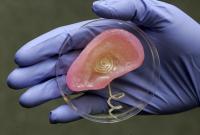 |
| Artificial Ear |
An artificial ear may soon replace a hearing aid. Scientists at Princeton University have used off-the-shelf printing tools to create a functional ear that can distinguish radio frequencies far beyond the range of normal human capability. The researchers' primary goal was to find a way to merge electronics and tissues. To create the artificial ear the scientists used a 3D printing of cells and nanoparticle and to combine a small coil antenna to the cartilage of the ear. The final product consists of a coiled antenna inside the cartilage structure and two wires that go from the base of the ear and wrap around the "cochlea," the part of the ear that senses sound, which connects to electrodes. Although there is much more time and studying needed, one scientists believes that the ear could possibly be used to restore, even, enhance human hearing. Like a hearing aid the electrical signals that are produced by the artificial ear could be connected to a patient's nerve endings, enhancing hearing. Although the current system receives radio waves, the research team plans to incorporate other material that may enable the artificial ear to register acoustic sounds. If this team succeeds who knows what we will be hearing, possibly someone's conversation in China!
Here's a link to the article- http://www.biologynews.net
N.O.S. Themes-
- Science is collaborative: many scientists are working on this project
- Science is based on evidence: the researchers have collected tons of data
- Conflicts within the scientific community: that are many people with poor hearing that would like to see this ear perfected
- Role of motivation and curiosity: the scientist would like to help all the people with bad hearing, plus they would make bank
This is incredible! I just read online that scientists are hoping to be able to use printed organs for a lot of different transplants. Scientists at Magic Arms were able to use 3D printing to create a device that helps a little girl with arthrogryposis use her arms.
ReplyDeletehttp://www.dezeen.com/2013/05/19/3d-printing-organs-medicine-print-shift/